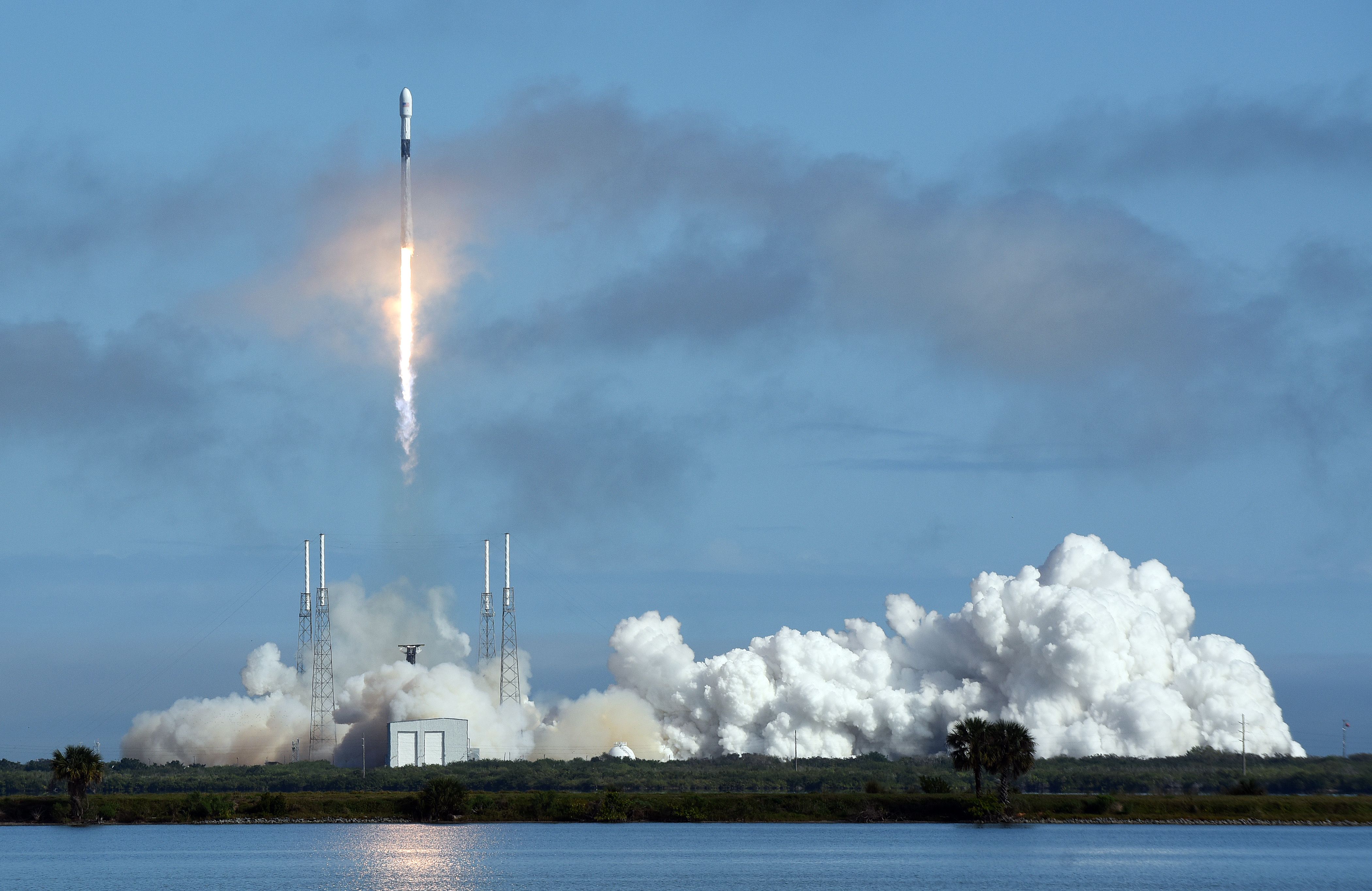Featured
SpaceX: Starlink is launched from Florida by less than a day after the California mission


We care about space, which is why we work hard to bring you the best coverage of the industry and Florida launches. This type of journalism takes time and money.
On Saturday, a SpaceX Falcon 9 rocket soared into clear skies above the Cape Canaveral Space Force Station, capping off a coast-to-coast flurry of launches just under 24 hours apart.
The 230-foot rocket fired from Launch Complex 40 at 4:40 p.m. EDT and delivered 53 Starlink satellites to low-Earth orbit less than an hour later. It was the internet-beaming constellation’s 47th launch.

It came after another Falcon 9 rocket launched the 47th batch of Starlink satellites from Vandenberg Air Force Base in California on Friday. SpaceX has delivered 106 Starlinks to orbit in the last two days, bringing the constellation’s total size closer to 2,500 operational satellites.
Saturday’s Cape mission featured a brand new booster, which flew flawlessly and landed on the Just Read the Instructions drone ship shortly after liftoff. It is expected to return to Port Canaveral for refurbishment early next week.
If schedules hold, the Space Coast will host a doubleheader next week.

On Wednesday, May 18, another SpaceX Falcon 9 will launch the company’s 48th batch of Starlink satellites from Kennedy Space Center. Because SpaceX has not yet confirmed the existence of this mission, details are limited, but liftoff is expected between 4 and 6 a.m. EDT.
A United Launch Alliance Atlas V rocket will take Boeing’s Starliner capsule on its second demonstration mission to the International Space Station 36 hours later. The capsule is scheduled to launch from Cape Canaveral’s Launch Complex 41 at 6:54 p.m. EDT. It is Boeing’s second attempt to reach the International Space Station with an uncrewed capsule after a 2019 test flight failed to meet objectives and had to return to Earth.

NASA chose Boeing and SpaceX to transport astronauts to the International Space Station after the space shuttle program ended in mid-2011. So far, SpaceX has transported five crews, while Boeing could transport its first before the end of the year if Thursday’s mission goes well.
Launch Wednesday, May 18
- Rocket: SpaceX Falcon 9
- Mission: 48th Starlink launch
- Launch Time: Early morning TBD
- Launch Pad: 39A at Kennedy Space Center
- Trajectory: Northeast
- Landing: Drone ship
- Weather: Forecast expected Sunday
Launch Thursday, May 19
- Rocket: United Launch Alliance Atlas V
- Mission: Boeing Starliner Orbital Flight Test 2
- Launch Time: 6:54 p.m. EDT
- Launch Complex: 41 at Cape Canaveral Space Force Station
- Trajectory: Northeast
- Weather: Forecast expected Monday

AI
OpenAI’s GPT-OSS Just Landed in Ollama — And It’s Quietly About to Break AI Rules
GPT-OSS Ollama integration unlocks 20B & 120B models with reasoning, tool use, and full local control. Learn the twist most devs are missing.

Estimated reading time: 5 minutes
Something weird just happened in the AI world.
OpenAI — the same company famous for locking GPT-4 in a vault — just tossed the keys to the open-source crowd.
And somehow… Ollama walked away with both the 20B and 120B GPT-OSS models in its pocket.
Here’s the part almost nobody’s talking about:
This isn’t just “you can run GPT locally now.”
It’s a blueprint for private, offline, self-owned AI agents that think, plan, and act — no API calls, no subscription, no data leaks.
Let’s crack open why this is bigger than it looks.
🧠 GPT-OSS: More Than Just “Open Source”
These aren’t stripped-down student projects.
GPT-OSS 20B and 120B come with:
- Native chain-of-thought reasoning (you can literally see how it thinks)
- Tool use + function calling baked in — no hacking required
- Agent-friendly architecture for workflows beyond chat
Ollama didn’t just host them — they built a developer-ready pipeline so you can go from install to fully-functional agent in minutes.
🚀 Why Ollama x GPT-OSS Is a Game-Changer
1. Fully Offline on Local Machine: No Cloud, No Fees, No Limits.
Run it entirely offline by downloading Ollama’s new app on your own macOS and Windows machine. If you’ve got 16GB VRAM, you’re good for 20B. 120B just needs more horsepower.
2. Agent-First by Default
Ollama’s integration supports Python tools, structured outputs, local APIs, multi-step planning, and web integration for full AI agents right out of the box. Build AI assistants that act, not just answer.
3. Transparent Reasoning
Ever wanted to see why an AI gave an answer? Now you can — and you can even debug its “thought process” mid-flow. These models show their work — a rare feature in AI that boosts trust and usability.
4. A Different League from LLaMA or Mistral
While LLaMA and Mistral are strong, GPT-OSS comes pre-wired for multi-tool workflows, making it action-ready, tuned for structured reasoning and action chaining out of the box.
⚠️ The Trap Most Devs Are Falling Into
A lot of people are treating GPT-OSS in Ollama like a demo toy. Install, run “Hello World,” move on. If you install GPT-OSS and just “try a few prompts,” you’re leaving 90% of its value on the table.
That’s a waste. The magic happens when you:
Build private, persistent, multi-tool agents that:
- Keep their own long-term memory
- Automate real-world tasks
- Build privacy-first copilots, and operate without ever touching OpenAI’s servers.
- Stack multi-agent workflows
Once you see it as your own personal AI infrastructure, the game changes.
💡 5 Real & High-Impact Projects You Can Build Right Now
- 📄 Private research analyst — scans docs, summarizes, cites, and stores findings offline. An assistant that reasons out loud and cites everything
- 📅 Smart local scheduler — Connects with your local calendar and email—no cloud syncing—and books your meetings for you.
- 📚 Guided tutor — Guides students step-by-step through coding, math, and complex problems—while showing exactly how it reasons.
- 🔐 Knowledge vault — A fully offline, AI-searchable databse of everything you’ve ever read or written.
- 💬 On-device customer service bot — Perfect for businesses that can’t risk sending client data to the cloud.
🧨 The Hidden Message from OpenAI — and Why It Matters More Than You Think
OpenAI’s release quietly acknowledges something huge: the next AI wave is agentic and local-first.
And Ollama? They’re not just participating — they’re building the rails for it.
If you’ve been waiting for the “privacy + power” sweet spot in AI… this is it.
🧵 TL;DR
OpenAI gave us GPT-OSS. Ollama made it run locally like a dream. This isn’t about faster chat — it’s about building your own AI infrastructure with no fees, no cloud, and no middleman.
Learn more about OpenAI’s latest advances on their official website.
❓ FAQs
Everything You’re Curious About:
Yes. Once installed through Ollama, you can run it fully offline. Internet is only needed for initial download or if your tools require it (e.g., live web search).
120B delivers deeper reasoning and more context memory, but it’s heavier. 20B is still strong enough for most agentic workflows and runs on more modest setups.
You can — Ollama supports custom models. But fine-tuning 120B requires serious compute and storage. Parameter-efficient tuning methods (LoRA, QLoRA) make 20B fine-tuning realistic for hobbyists.
Since data never leaves your machine, you sidestep most cloud compliance risks. That said, responsibility for secure storage and access control is still yours.
In many cases, yes. GPT-OSS has stronger native reasoning and function-calling, making it ideal for coding tools, local copilots, and multi-step workflows.
No promises. GPT-OSS is a rare move from them. The AI community is watching closely to see if this was a one-time drop or the start of a trend.
Yes — Ollama lets you swap or chain models, so GPT-OSS can handle logic while another model handles style or language.
GPT-OSS is designed for action, not just text — function calling, structured output, and multi-tool orchestration come native.
Yes — and Ollama lets you log it, making it great for debugging or educational tools.
For many agentic tasks — yes. Especially when combined with local APIs, tools, and memory. But GPT-4 still wins in raw generalization.
OpenAI released GPT-OSS under a permissive license for research and commercial use, but check the repo for fine print.
Featured
Asia’s Trending Travel Spots to Visit This Summer
From Tokyo’s summer festivals to rooftop gardens in Singapore, Asia’s top destinations are heating up this season—with Seoul, Taipei, and KL also on the rise.

As summer unfolds, more travelers are turning their eyes toward Asia—not just for its iconic landmarks, but for the unique local experiences that each destination offers after the monsoon haze clears and festivals begin. This year’s top trending places blend urban energy with cultural flavor, making them perfect for mid-year escapes.

Tokyo, Japan – Festivals, Food, and City Feels
Tokyo is never short on energy, but summer gives it a different glow. The streets fill with lanterns, music, and festival-goers as traditional matsuri take over parks and neighborhoods. Some visitors come for the chaos of Shibuya, others for the peace of a tucked-away shrine. But what draws people back is the feeling that every corner of the city has a story unfolding.

Osaka, Japan – Summer with a Side of Street Food
If Tokyo is all rhythm, Osaka is all flavor. The city is famous for its street food culture, especially in districts like Dotonbori, where the scent of grilled skewers and sizzling okonomiyaki leads you through narrow alleys buzzing with life. Add in summer fireworks and night markets, and Osaka becomes a playground for the senses—especially if you like your meals served with a side of chaos.

Singapore – Cool City, Hot Weather, Smart Escape
Yes, it’s hot. But Singapore makes up for the heat with lush greenery and modern cool. From sky-high gardens to air-conditioned art galleries, it’s a city that knows how to keep you moving without melting. As the sun sets, light shows take over Marina Bay, and rooftop bars hum with conversation. The city feels both futuristic and grounded—small enough to explore, big enough to keep you guessing.

Kuala Lumpur, Malaysia – Always Something New
Kuala Lumpur moves at its own pace. One minute you’re standing in front of a 100-year-old mosque, the next you’re walking through a neon-lit shopping district. It’s a city of contrast, which is what makes it exciting. And during summer, there’s a quieter charm—fewer crowds, more deals, and the chance to explore the city’s hidden corners without the rush.

Seoul & Taipei – For Quick Getaways That Stick
Seoul and Taipei are becoming the go-to options for travelers short on time but big on curiosity. These cities offer just enough culture, food, and nightlife to fill a long weekend without feeling overwhelming. Wander through a Seoul backstreet for late-night barbecue, or catch a music performance in Taipei’s creative districts—both cities pack a punch in a few short days.
Featured
Dubai and Abu Dhabi Named Among World’s Safest Cities to Explore at Night
Dubai glows as one of the most scenic cities after sunset, while Abu Dhabi earns global recognition for safety—cementing the UAE’s status in night tourism.

When it comes to enjoying city life after dark, few places compare to the UAE’s two iconic hubs: Dubai and Abu Dhabi. A recent global ranking has placed Dubai among the top three most scenic cities at night, while Abu Dhabi stands tall as the safest city in the world once the sun goes down.
Dubai After Dark: Where the Skyline Comes Alive
Dubai’s nighttime atmosphere is something else entirely. The skyline lights up in gold and neon, creating a dazzling contrast against the calm waters of the coast. Late-night cafés, rooftop lounges, waterfront promenades—everything feels curated for night explorers.
Despite its energy, Dubai manages to keep things balanced. The city offers a vibrant nightlife without overwhelming its guests, making it ideal for travelers who want both adventure and comfort.
Abu Dhabi: The Calm, Safe Capital
While Dubai draws attention with lights and flair, Abu Dhabi offers peace of mind. Known for its low crime rates and quiet evening vibe, the capital is the perfect place for a relaxed night walk or a late coffee without the crowds.
The city doesn’t overwhelm with noise or traffic after hours. Instead, it gives visitors space to breathe. It’s this combination of security and serenity that makes Abu Dhabi stand out for nighttime explorers.
Noctourism Is on the Rise
Travel habits are changing. More people now prioritize what a city feels like at night—how it sounds, how safe it is, and whether there’s anything to do after dinner. This shift, often referred to as “noctourism,” is especially relevant in the UAE, where warm evenings invite people outside well into the night.
Both cities cater to this growing trend in their own way. Whether you’re catching a light show in Dubai or enjoying a silent walk along Abu Dhabi’s quiet streets, the UAE is quickly becoming a go-to destination for night-focused travelers.
Planning to experience the magic of Dubai or the charm of Abu Dhabi after dark? Online booking platforms like Explorer Shack offers hassle-free attraction tickets booking and unlocking the best the UAE has to offer—without the wait.









